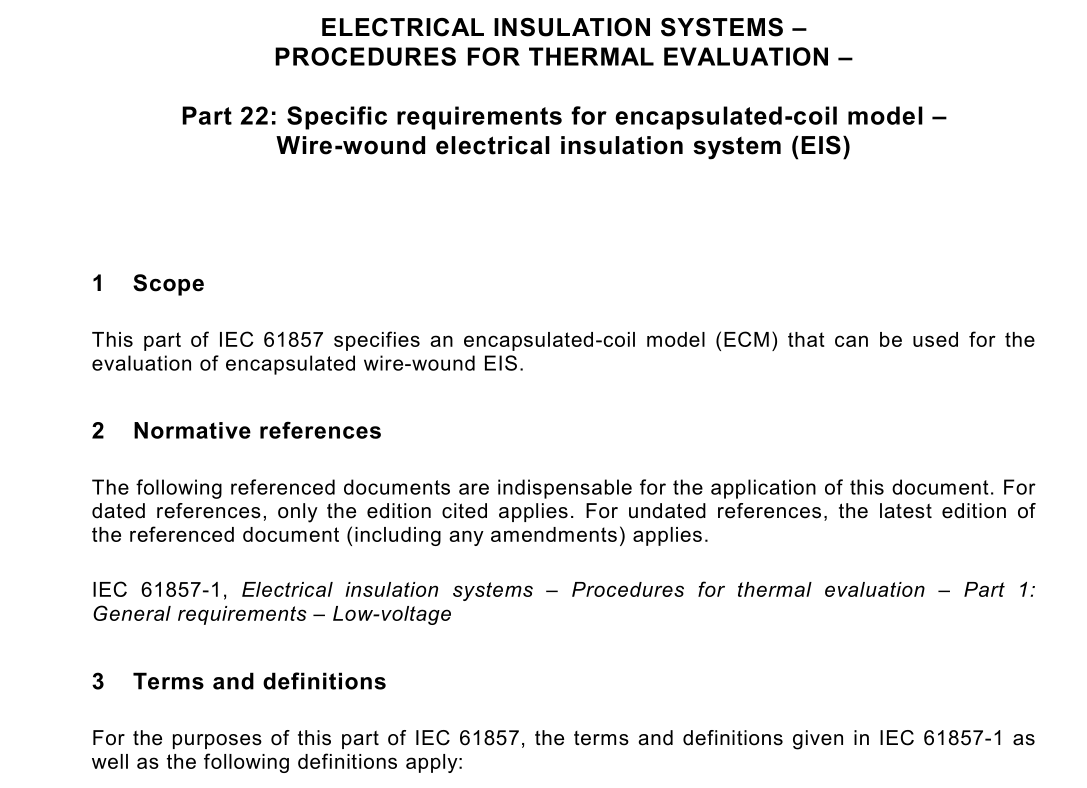IEC 61857-22 pdf download

IEC 61857-22 pdf download.Electrical insulation systems – Procedures for thermal evaluation
1 Scope
This part of IEC 61857 specifies an encapsulated-coil model (ECM) that can be used for the evaluation of encapsulated wire-wound EIS.
2 Normative references
The following referenced documents are indispensable for the application of this document. For dated references, only the edition cited applies. For undated references, the latest edition of the referenced document (including any amendments) applies. IEC 61857-1, Electrical insulation systems – Procedures for thermal evaluation – Part 1: General requirements – Low-voltage
3 Terms and definitions
For the purposes of this part of IEC 61857, the terms and definitions given in IEC 61857-1 as well as the following definitions apply: 3.1 encapsulant electrical insulating material (EIM) that completely encases the coil except for connections to the exterior, and is part of the electrical insulation system (EIS) NOTE The encapsulated-coil model (ECM) does not employ a supplemental shell. 3.2 encapsulation process of applying an encapsulant NOTE For the purpose of evaluating an electrical insulation system (EIS), the process may consist of injection moulding, compression moulding, casting or other techniques. 3.3 bobbin form around which a coil is wound 3.4 coil continuous winding of insulated wire 3.5 interwinding insulation electrical insulating material (EIM) between individual coils
4 Construction
4.1 General information The ECM is useful in evaluating the compatibility of EIMs used in a candidate EIS. It is equally capable of simulating the influences of actual manufacturing processes such as winding techniques, termination techniques and encapsulation. The essential parts of the ECM are a bobbin, winding wire, wire connectors and encapsulant. The winding wires may be connected to binding posts or to lead wires, either of which extends through the encapsulant wall. 4.2 ECM components a) Coil: the coils may be wound with two wires in parallel (bifilar winding) or may be wound with a single wire. b) Wire: winding wire, heavy film coated; 0,4 mm to 0,6 mm diameter wire size is preferred. c) Earth insulation: the EIM used as the bobbin and the EIM used as the encapsulant function as coil-to-earth insulation. An EIM evaluated only as a coil bobbin shall not also be used as an encapsulant material. An EIM used as an encapsulant shall be evaluated as such. d) Tape: electrical tape may be used but unless electrically stressed and evaluated is not part of the EIS. e) Connectors: the winding wires are connected inside the encapsulant to binding posts or lead wires. These connections are essential parts of the ECM. f) Electrical impregnating resin/varnish: this may be part of the EIS if applied prior to the encapsulation process. NOTE A metal frame or a lamination stack that may be incorporated into the test object is not an essential part of the test object if it does not function as a fault path. 4.3 Assembly of the ECM a) Wind the winding wire over the bobbin using accepted winding techniques. b) As appropriate, use electrical grade tape or other components to secure the winding wire in place. c) Connect the winding wire to the binding posts or lead wires. d) If part of the candidate EIS, apply impregnating resin/varnish. e) Apply the encapsulant material.
6 Test procedures
6.1 General All test objects shall be subjected to initial screening tests followed by repeated thermal endurance test cycles in the following order: a) a thermal ageing subcycle; b) a subcycle of pre-diagnostic mechanical stress, other pre-diagnostic requirements, and moisture exposure, in that order; c) a dielectric diagnostic test. 6.2 Initial screening test 6.2.1 General Prior to exposure to an elevated temperature on the first thermal ageing subcycle, all test objects shall be subjected to initial screening tests in order to eliminate defective test objects. The initial screening tests shall consist of the following steps and shall be conducted in the order given: a) visual inspection; b) nitial dielectric test (see 6.2.2); c) mechanical stress (see 6.3.3); d) thermal shock, as required (see 6.3.4) e) moisture exposure (see 6.3.5); f) dielectric diagnostic test (see 6.3.6). 6.2.2 Initial dielectric test An initial screening test utilizing dielectric techniques shall be performed on each ECM test object prior to application of other prediagnostic stresses and thermal ageing (see table 1).









